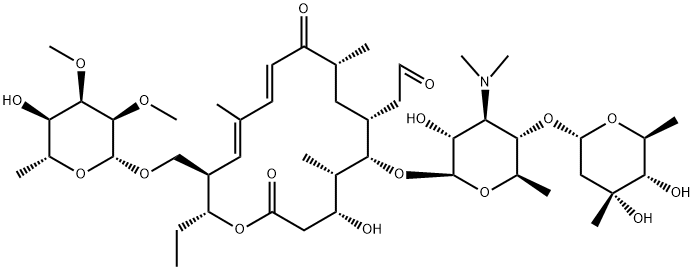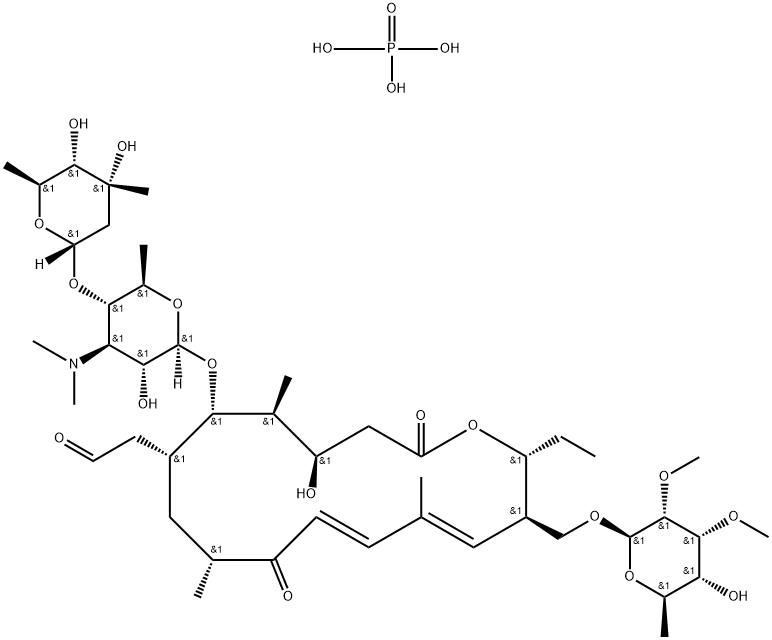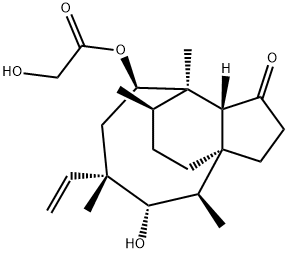BD0616245
Tylosin , 98% , 1401-69-0
Synonym(s):
Tylosin A
CAS NO.:1401-69-0
Empirical Formula: C46H77NO17
Molecular Weight: 916.1
MDL number: MFCD09881413
EINECS: 215-754-8
| Pack Size | Price | Stock | Quantity |
| 100mg | RMB56.00 | In Stock |
|
| 250mg | RMB84.00 | In Stock |
|
| 1g | RMB208.00 | In Stock |
|
| 5g | RMB635.20 | In Stock |
|
| others | Enquire |
Update time: 2022-07-08
PRODUCT Properties
| Melting point: | 135-137°C |
| alpha | D25 -46° (c = 2 in methanol) |
| Boiling point: | 796.05°C (rough estimate) |
| Density | 1.1424 (rough estimate) |
| refractive index | 1.5280 (estimate) |
| storage temp. | Sealed in dry,2-8°C |
| solubility | DMF: 30 mg/ml; DMSO: 25 mg/ml; Ethanol: 30 mg/ml |
| form | A crystalline solid |
| pka | pKa 7.73(H2O
t = 25
I = 0.167) (Uncertain) |
| color | White to light yellow |
| Water Solubility | H2O: soluble 50 mg/mL |
| Stability: | Solutions are stable at pH 4-9 (most stable at pH 7); Below pH 4 tylosin B (desmycosin) is formed as a result of acid hydrolysis; In neutral and alkaline pH – tylosin aldol (TAD) is formed together with polar degradation products of unknown identity; When tylosin solution is exposed to daylight, a photodegradation product - isotylosin A (isoTA) is formed. |
| InChIKey | WBPYTXDJUQJLPQ-VMXQISHHSA-N |
| EPA Substance Registry System | Tylosin (1401-69-0) |
Description and Uses
Occupational exposure concerns farmers, breeders, animal-feed workers and veterinarians.
Macrolide antibiotic isolated from a strain of Streptomycetes fradiae found in soil from Thailand. Antibacterial.
Safety
| Symbol(GHS) |  GHS08 |
| Signal word | Danger |
| Hazard statements | H317-H334 |
| Precautionary statements | P261-P272-P280-P284-P302+P352-P333+P313 |
| Hazard Codes | Xn,N |
| Risk Statements | 42/43-50 |
| Safety Statements | 36-61-45-36/37-22 |
| HS Code | 2941906000 |
| Hazardous Substances Data | 1401-69-0(Hazardous Substances Data) |
| Toxicity | Tylosin base and its salts were shown to be of low acute oral toxicity with LD50 values in excess 5000 mg/kg bw in the rat and mouse and greater than 800 mg/kg bw in the dog. |






